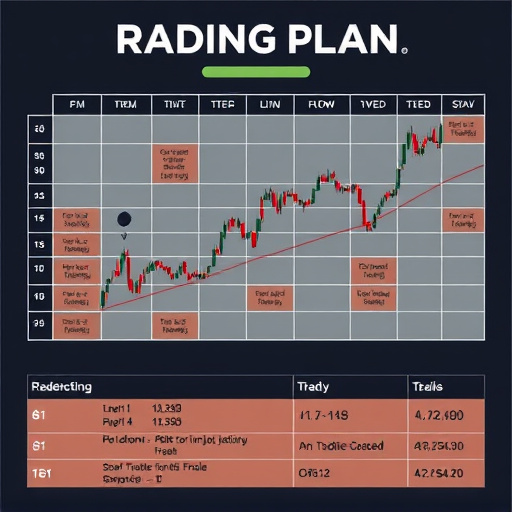Master Your Trading: Craft a Structured Plan for Success
A successful trading plan is a strategic roadmap for navigating financial markets, tailored to individual goals, risk tolerance, and market analysis. It involves identifying your trading style, selecting indicators, managing risk through positio…….

A successful trading plan is a strategic roadmap for navigating financial markets, tailored to individual goals, risk tolerance, and market analysis. It involves identifying your trading style, selecting indicators, managing risk through position sizing and stop-loss orders, and tracking performance. By defining clear objectives, choosing asset classes, and refining strategies through backtesting, traders can create an adaptable plan to maximize returns and navigate volatility effectively. Regular reviews ensure the plan stays dynamic, relevant, and disciplined in changing market conditions.
Unleash your inner trader by unlocking the secrets of a robust trading plan. In today’s dynamic market, a well-structured strategy is key to navigating uncertainty and maximizing gains. This comprehensive guide takes you on a journey through the essential components of a successful trading plan, from setting clear goals and defining strategies to implementing risk management techniques and refining your approach through backtesting. Discover how to adapt and evolve, ensuring long-term success in the ever-changing world of trading.
- Understanding the Foundation of a Trading Plan
- Defining Your Trading Goals and Strategies
- Creating a Structured Actionable Roadmap
- Risk Management: Essential for Long-Term Success
- Backtesting and Iteration: Refining Your Plan
- Adapting and Evolving in a Dynamic Market
Understanding the Foundation of a Trading Plan

A well-defined trading plan is the bedrock of successful navigating in the financial markets. It serves as a strategic roadmap, outlining clear entry and exit points for trades based on established criteria. This fundamental tool isn’t just about setting random rules; it involves meticulous analysis of market behavior, personal risk tolerance, and investment goals. By understanding these foundational elements, traders can create a plan that aligns with their unique strategies.
The process begins with defining one’s trading style—whether it’s short-term scalping, swing trading, or long-term investing. This is followed by identifying key indicators and signals that will trigger trade entry and exit. Risk management is another crucial component, where parameters for position sizing and stop-loss orders are determined to safeguard capital. A robust trading plan also incorporates a system for tracking performance and making adjustments as market conditions evolve.
Defining Your Trading Goals and Strategies

Defining your trading goals is a crucial step in crafting a successful trading plan. It’s essential to be specific and measurable. Are you aiming for consistent monthly returns, capital preservation, or aggressive growth? Your strategy should align with these objectives, taking into account factors like risk tolerance and time commitment.
Next, articulate the tactics and tools that will underpin your approach. This could involve identifying preferred asset classes, setting entry and exit criteria, or choosing specific trading indicators. A well-defined trading plan acts as a roadmap, guiding your decisions and keeping you focused, even in the face of market volatility.
Creating a Structured Actionable Roadmap

A well-structured trading plan is akin to a detailed roadmap, guiding traders through their financial journey with clarity and purpose. It’s not just a collection of rules but a strategic framework designed to navigate market uncertainties. By creating this actionable roadmap, traders can transform vague ambitions into concrete steps, ensuring every decision is aligned with their overarching goals.
This roadmap should be tailored, outlining specific trading strategies, risk management techniques, and entry/exit points based on sound analysis. It must be flexible yet disciplined, allowing for adjustments as market dynamics evolve. Regularly reviewing and refining this plan fosters adaptability, enabling traders to stay the course during volatile periods while capitalizing on emerging opportunities.
Risk Management: Essential for Long-Term Success

Risk management is a cornerstone of any well-crafted trading plan, playing a pivotal role in ensuring long-term success. It’s not just about minimizing losses; it’s about maximizing returns while maintaining a strategic and disciplined approach. By integrating risk management strategies into your plan, you gain a powerful tool to navigate the markets’ inherent volatility.
Effective risk management involves setting clear stop-loss orders, diversifying your portfolio, and adhering to position sizing guidelines. These practices allow traders to protect their capital, enabling them to weather market storms and capitalize on opportunities over time. When executing your trading plan, remember that managing risk is an ongoing process that requires constant assessment and adjustment.
Backtesting and Iteration: Refining Your Plan

Backtesting and iteration are essential components in refining your trading plan. By applying historical data, you can assess the effectiveness of your strategy and identify potential weaknesses or strengths that may have been overlooked. This process involves simulating trades based on predefined rules, allowing you to evaluate performance metrics such as profitability, risk management, and overall consistency.
Through continuous backtesting and tweaking, you can optimize your trading plan to better suit market conditions and personal risk tolerance. Each iteration provides valuable insights, helping you make informed adjustments that could significantly enhance your trading success. Embrace this iterative approach to continuously refine and improve your trading strategy, ensuring it remains adaptable and effective in the dynamic world of markets.
Adapting and Evolving in a Dynamic Market

In the ever-changing landscape of financial markets, a static trading plan can quickly become outdated and ineffective. A robust trading plan should be viewed as a living, breathing entity that adapts to the dynamic nature of the market. Successful traders recognize that flexibility is key, allowing them to evolve their strategies based on shifting conditions. This adaptability involves staying informed about market trends, news, and events that could impact asset prices. By being agile, traders can adjust their entry and exit points, risk management rules, and position sizes accordingly.
Regularly reviewing and refining one’s trading plan is essential to stay ahead of the curve. Markets are inherently unpredictable, and what works on a given day might not be optimal the next. Traders who embrace change and remain receptive to new ideas are better equipped to navigate these volatile environments. This evolution within the trading plan ensures that it remains tailored to individual goals, risk tolerance, and market dynamics, ultimately enhancing the chances of consistent profitability.
A well-crafted trading plan is your compass in navigating the markets, ensuring long-term success. By understanding the fundamentals, defining clear goals, and implementing structured strategies, traders can unlock their full potential. Risk management, backtesting, and adaptability are key components to refining and evolving your approach over time. Embrace the process of continuous improvement and let your trading plan be a dynamic guide, enabling you to navigate the ever-changing landscape with confidence.







